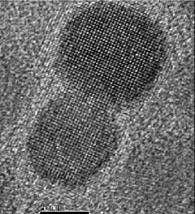Victor Klimov and Richard Schaller at Los Alamos National Laboratory have enhanced the phenomenon called "impact ionization," which can significantly improve the efficiency of the conversion of solar energy to electrical current. Normally, an incident photon striking a semiconductor produces an electron-hole pair plus a bit of heat. By using sub-10-nm sized nanoparticles made of lead and selenium atoms, the Los Alamos scientists encourage the interaction to spawn a second exciton instead of the heat (see picture, which shows hi-resolution TEM image of epitaxially fused PbSe NanoQuantumDot pair.
Greatly improved solar cells might result from the use of a photophysical process in which for each incident solar photon not one but two excitons (electron-hole pairs) are created, says Physics News Update. As with photosynthesis what happens in a solar cell is the conversion of light energy into a small current of electrons; in plants the freed electrons helps to build glucose; in solar cells the currents are collected in the form of electricity.
Although they haven't yet built a working solar cell, they are the first to demonstrate the efficacy of getting the PbSe nanocrystals to render more photo-current. Implementing the new process might result in efficiency gains of more than 35% in the conversion of light to current. (Physical Review Letters, upcoming article)
See also the group website.
























